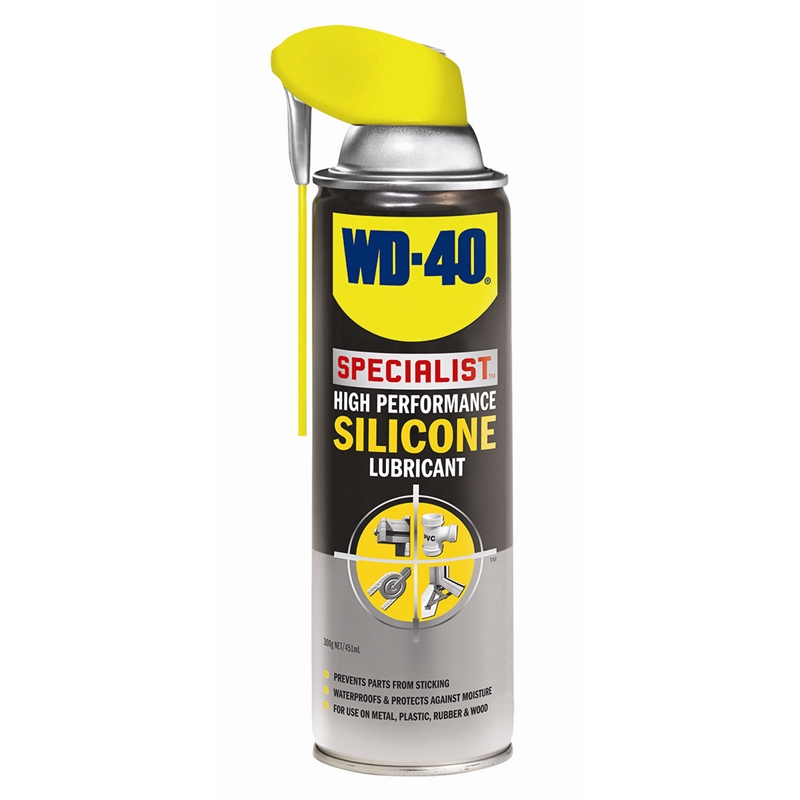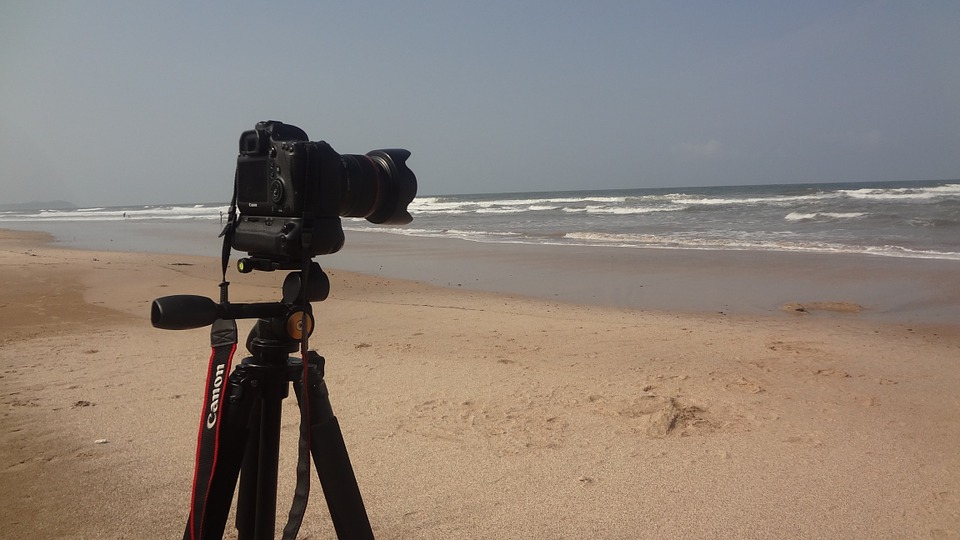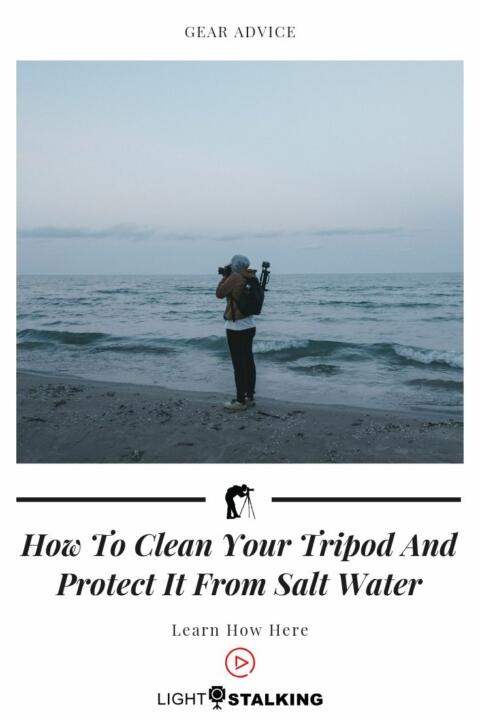Tripods are one of the most important photography accessories that most landscape and night sky photographers carry around. Most often these are the least looked after or maintained gear as some photographers, especially beginners are not aware of the damages that sand, dirt, mud and/or sea water can cause to these accessories. Looking after your tripod is essential for its long life which means, you need to clean your tripod when required, especially after a shoot in the beach to protect it from salt water.
Depending on where one shoots, there are huge possibilities for these gear to get into a mess with all the mud, dirt, sand, sea water they are used to shoot in. Dirt, sand, and seawater can be the worst enemies when it comes to a tripod and these can make it very difficult for the tripod to function properly.

So what do you do when you have to use your tripod in these situations? You have to either protect your tripod from catching the dirt from outside or you will have to clean the tripod perfectly after the shoot, so you can have it functioning normally. So, how do you clean your tripod and protect it from salt water is an important question asked by many photographers especially when they are used in or near sea water. There are ways in which you can protect or clean your tripods so they perform well and have a longer life.
When using your tripod you can try one of the few ways below to protect your tripod from the dirt, grime, sea water, etc.
Here Are Some Cheaper Ways To Protect Your Tripod:
- There are foot pads or all-weather shoes for tripods that are designed to protect the legs by giving them a large foot-area thereby preventing them from sinking into the sand, mud or dirt. While these shoes can help prevent your tripod legs from sinking into sand, mud or other soft surfaces, these will not help if you are going to be using your tripod in the water, like for example sea water in the beach.
Note: Manfrotto and Gitzo manufacture something called snowshoes to prevent the tripod from sinking in the snow which can also be used in mud and sandy areas.

- Very similar to the above, you can make use of any sturdy plates under the tripod feet to prevent them from sinking in.
- You can use three tennis balls for the three legs. Just make a small opening on the ball in an X shape, just big enough to slip the leg through and hold them. This way, if you are going to be using your tripod in dirt or sand, you can protect the legs from sinking in and/or carrying dirt or sand in.
- If there is more sand, dust or water, here is another quick way to protect your tripod. If you use the tripod most of the time in mud, dirt, sand, water or sea water, then use plastic sleeves (usually sold in rolls and can be purchased by the number of meters you need) to wrap around the tripod legs and use ties, adhesive tapes = or rubber bands to secure them in place. This way you can put your tripod in mud, sand, water, etc. without having to deal with much trouble later on with the only limitation being unable to adjust the leg heights. Bear in mind, this method may not work well for situations where you may have to get really deep into the water, in which case, your tripod will almost be completely in water and in these situations, you will have to give your tripod a thorough clean after the shoot.
All the above methods will cost you just a few dollars and these materials or things are available to purchase easily online. Even with the above methods, there are chances that sand or salt water can get through, so it is always safe to do a rinse with clean water once you finish your shoot.
If you were not able to avoid getting dirt, sand or salt water onto your tripod, then the next step is cleaning your tripod thoroughly and this has to be done as soon as possible before the salt or the dirt can settle down and cause irreparable damage to your tripod. Especially when you shoot on a beach or in seawater, it is amazing how far into the tripod legs the sand can get, and, the amount of sand that you will find when cleaning the tripod is amazing. So get your tripod cleaned after you finish a shoot in these type of locations, as soon as possible, and it is best to do the cleaning or at least a good rinse before you collapse the legs.
Before going into those details of cleaning the tripod, let us take a quick look at,
What You Will Need To Dismantle And Clean Your Tripod:
- Soft cotton cloth and/or microfibre cloth
- A mild organic cleaning solution
- Warm water
- Soft brush and a soft sponge
- Silicone-based lubricant
- Tools like screwdrivers, socket wrench to dismantle your tripod
- A container to keep the tiny parts, bolts, and screws safe
- A neat and clear working space – preferably a light coloured space, so you do not miss tiny parts.

Here Are The Steps Involved In Cleaning A Tripod:
- Firstly, as soon as possible, use a blower to blow off any sand sticking on to the parts of the tripod and pour as much clean warm water on your tripod as soon as possible so that the salt water and any dirt or sand sticking to it does not dry and deposit salt and grime on the tripod legs, head and in parts like screws, locks, etc.
- Dismantle your tripod – most tripods should allow you to do this. If you have a manual that has instructions to dismantle, please follow the instructions.
- Some tripods like the Manfrotto, Gitzo, Really Right Stuff, allow for dismantling the entire tripod and cleaning. So, pull out each part of the legs including the feet, center column, flip or twist locks, screws, etc. If you think you will get confused while assembling the tripod, make sure you take pictures of the dismantling process, so you can go back to refer when you assemble.
- Keep the parts arranged in a way, so that, it is easier for you to put them back together. Arrange them in the order you removed them, so you know which one should be put together first. Also, make sure you do not misplace the tiny bits like screws, retaining caps, etc.
- Clean the joints, screwable areas and screws with a soft brush and mild organic cleaner and then with clean warm water, till you think that every bit of mud, sand, dirt, and salt has left the tripod. Do not scrub the threads, instead run the brush along the threads to remove the dirt and sand. You can finish off with a soft sponge in the end.
- Do not forget to clean the inside of the legs as any sand in there will stop the legs from sliding in and out. Do not use strong cleaners or abrasives as they can damage the coating and even damage the tripod material.
- After cleaning the tripod parts, wipe them dry with a clean soft cloth
- Once done and dried, in order for your tripod to work smoothly, which means in order for the legs and centre column to glide smoothly, you will need to lubricate your tripod. Apply a silicone-based lubricant to the joints, threads, locks, and parts of the tripod that need lubricating and gently wipe off any excess lubricant sticking elsewhere with a soft cotton or microfibre cloth. This way, any remaining dirt also gets removed and the tripod legs can slide smoothly.
- You do not need to clean the tripod head area all the time if you know for sure that sand or salt water has not got into those areas. But if you think sand or salt water from the air would have settled on your tripod then, by all means, make sure you clean all parts of the tripod.
The final part is to put the tripod back together and this needs to be done with utmost care. This is a very important step where you need to be very careful and make sure that you put the parts back where they belong.
- Take care in order to have the retaining caps put back correctly as they are an important part of the legs.
- Make sure you put back the locks correctly as these are responsible for having the tripod legs in place when they are expanded and collapsed.
- Any rubber rings or bolts need to be in place and put back in the correct order.
- Look for any notches and/or arrows that indicate how parts need to be put together.

What If You Cannot Dismantle Your Tripod?
You can still flush each joint with hot soapy water and use a soft brush to remove dirt from grooves and in between the locks. Extend the legs out and clean and leave it to dry before collapsing the legs.
How Often Do You Need To Clean Your Tripod?
- The frequency with which your tripod needs cleaning depends on your type of photography, but if you shoot outdoors, it is good to give a little rinse with warm water after every shoot. Also if you shoot in the rain, rinse the tripod and let it dry.
- If you frequently shoot outdoors you may need to clean your tripod thoroughly once every 3 to 6 months.
- There are times when your tripod may require immediate cleaning – situations when you hear grating or grinding sounds in the locks or when expanding and collapsing the legs, you know for sure there is something in there like sand or other dirt, then you need to immediately clean it. If you don’t, this can damage the coating on your tripod and make your tripod prone to corrosion.
- Your tripod also needs to be cleaned immediately if you submerge your tripod in salt water, especially when shooting in beaches, swamps, etc., then your tripod will need immediate cleaning because salt water is corrosive and there is a good chance for a lot of sand to have got caught in the tripod.
Taking care of your tripod when required like mentioned previously can extend the life of the tripod rendering it usable for many years.
Do you use a tripod while shooting outdoors? If yes, how often do you clean your tripod? Do you have any tips on cleaning tripods? If yes, please leave your tips in the comments section below.
Further Resources:
- How to Motivate Yourself to Carry Your Tripod Along More Often
- What Photographers Need to Know Before Buying a Tripod Head
- Taking a Walk With Your Three Legged Friend
- Maintaining Your Tripod
- The Best Camera Lens Cleaning Kits
- Cleaning and Maintaining Your Tripod’s Leg Lock
- How to Clean Your Tripod and Make it Like New
Shareable Images for Pinterest











3 Comments
An informative and timely article for me. With spring just around the corner where I live I’m planning on visiting the Oregon coast frequently to photograph the beautiful coastline here. In the past I’ve not done a very good job at cleaning my tripod so this is a much needed and helpful reminder. Thank you.
Dave.
Hi Dave, thank you and glad that you found this helpful 🙂
I just found my old tripod in my room that I can use this on!
I’ll definitely need to take pictures before dismantling, since I am the world’s worst person at putting things back together. Thanks for the tips!!!!!!
Thank you so much again! Keep up the great work.